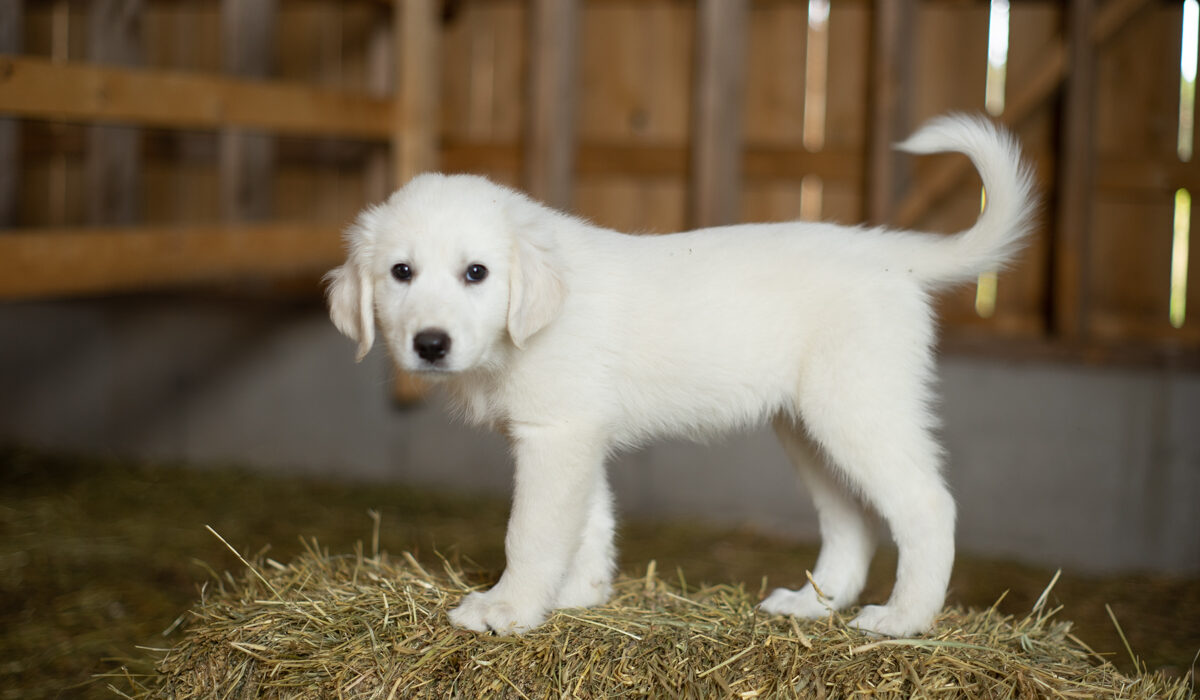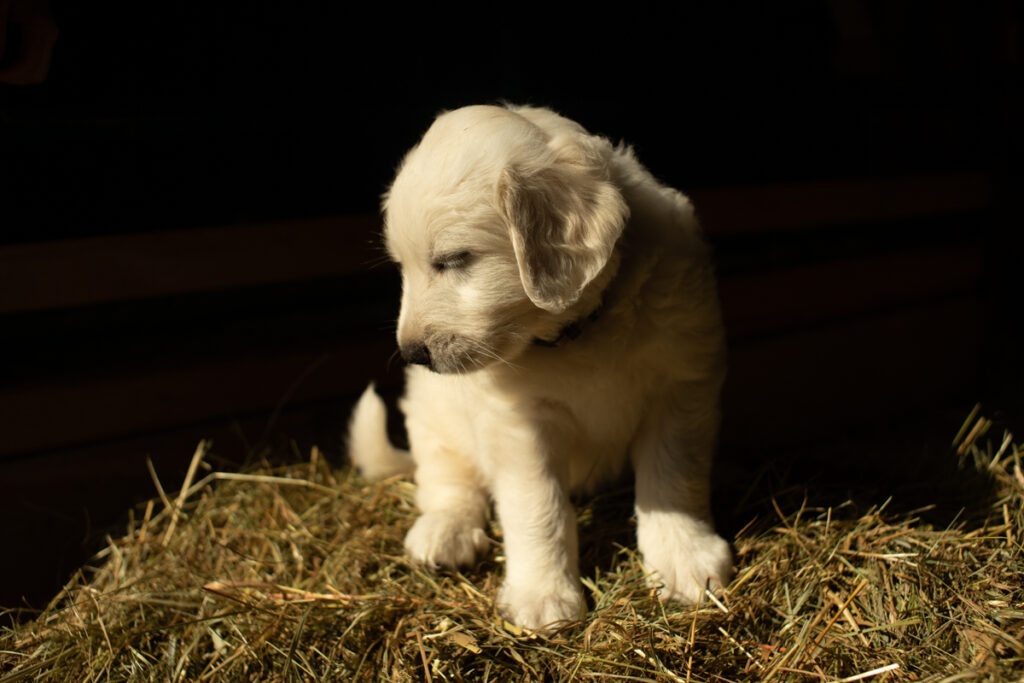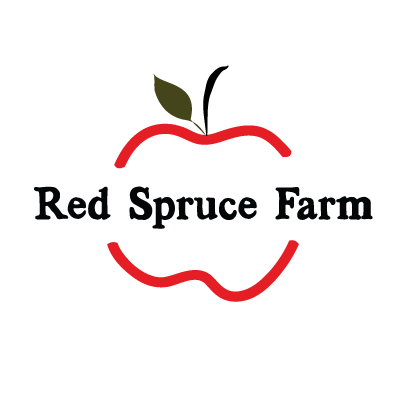
Great Pyrenees Breeders
Red Spruce Farm breeds great Pyrenees as livestock guardian dogs in Pictou County, Nova Scotia, in Atlantic Canada.
Our great Pyrenees are working dogs, they protect our herd of North Country Cheviot ewes (sheep), and alpine x boer does (goats). They have full access to our barn, and full access to the fields where our livestock graze.
Please contact us for puppy availability, next expected litter, and pricing.
About our great Pyrenees Kennel
Rosie

Rosie is our current great Pyrenees dam. She was born on December 31, 2019. She has a medium to light double coat that is pure white. She weighs 85 lbs.
She is an adventurous dog that can spot a silent owl in the night to bark at. She is very graceful in her athleticism, dancing her way around any mud puddles and over any fence she wants.
Pogo

Pogo is our current great Pyrenees Sire. He was born January 5, 2020. He has a thick mane and all around thick double coat. He weighs 118 lbs.
Pogo is the perfect livestock guardian anybody would wish for. He ignores anything that’s not a threat and is immediately on alert when the coyotes start howling. He spends his nights patrolling the fence line and spends his days sleeping.
Great Pyrenees Puppies

About once a year we have a litter of great Pyrenees puppies. They range in size from 5 – 15.
Our puppies are all dewormed at 2, 4, and 6 weeks of age. Their first vaccinations, as recommended by our local vet, are for distemper, CAV2-hepatitis, parvovirus, and parainfluenza, done at 8 weeks. At this time the puppies are ready for their new homes.
We let the dam tell us when she is ready to start partially weaning the puppies. We do this by slowly integrating some wet and soft puppy food. Each puppy gets it’s own dish and rapidly finds an interest in the new source of food. After about 6-7 weeks, the puppies will be nearly weaned and onto puppy kibble food. When you come to take your new puppy home, we will provide a bag of their current food for you to slowly transition the puppy onto your puppy food with. This method is more kind to their systems than an immediate diet switch.

Our puppies are born and stay mostly in our barn. The barn also houses our goat and sheep in the winter, but the puppies have their own pen.
We welcome potential new livestock guardian dog owners to our farm to experience and talk about livestock guardian dogs in general, or to see our puppies and how our dogs act at home before deciding if a large breed livestock guardian dog is the right fit for your farm or homestead.
Great Pyrenees Breed Characteristics
Great Pyrenees dogs have thick coats. Generally they are all white, as our dogs are, but they can have some gray or tan markings and still remain true to breed. This thick coat makes their cold hardiness exceptional. We regularly see our dogs, in the freezing cold and blowing snow, sitting on watch in their characteristic on guard stance, in full zen mode. These same thick coats also require regular combing or matting will occur with the shedding undercoat in the spring through summer.

It takes large breed dogs around 2 years to reach full maturity. Females average 80 lbs and males average 120 lbs at full size. When standing at your side, their head will be around 3 ft (100 cm) and their front shoulders will be around 28″ (71 cm).
Great Pyrenees dogs are working dogs. They are livestock guardians. They have been recorded as being bred for livestock guardian work for 3000 years in the Pyrenees Mountains between France and Spain. This means they like to work. If they don’t have a herd to guard, they will try and guard something else like their humans. As with all dogs: a tired dog is a happy dog. If great Pyrenees dogs are working, they’re happy and tired. Most working dogs out of work (not tired from working) will begin to develop undesired characteristics.
Great Pyrenees dogs guard by barking. If a sudden outburst of barking occurs in the middle of the night, we know they’ve sensed some form of predator and are working diligently. When sheep are lambing, they will be on guard in this especially sensitive time to make sure our ewe is safe. For homes that do not have this guardian work for the dogs (and sometimes even for farms that do have this work for the dogs), this means that visitors to the farm could be considered as threats. Nobody wants a 100 lb dog approaching them barking, so a livestock guardian dog owner is always wise to keep this in mind.
Large breed dogs at full size require about 500 g – 600 g (5 – 6 cups or about 1lb) of dog food a day. Each brand of dog food will have suggested servings for their food so this varies, but also each dog will tell you how much it needs to eat. This gives you a rough idea of how much dog food you will be needing to buy to keep your fully grown dog full. Large breed dogs have an increased risk in twisted gut which comes from eating too much too quick, therefore it is better to feed more servings in the day than all at once for your great Pyrenees, a large breed dog.

The personality of great Pyrenees dogs is very comforting. They are gentle, wise, and zen like when they’re off duty. Upon entering the barn, a troupe of great Pyrenees will meet us vying for scratches upon the heads. They do get excited and play with each other like big lumps of beasts, flopping over anywhere and tugging at each other’s necks. If it has been a long night of chasing off predators, the dogs will all be sleeping in their chosen corners. Towards the age of 3 the dogs will start to spend less time looking for fun and more time relaxing and watching the bustle of the day. At any time, when the sound of a threat is heard livestock guardian dogs should instantly jump to duty, looking for the source of threat and barking warnings at it.
Heat cycles and pregnancy will bring out the protective nature in any dam, as will strangers and predators. All animals benefit from socialization to an environment they should be comfortable in. Comfort for a dog means a wagging tail, looking for scratches, smelling smelly spots, or just raising an eyebrow from their sleeping position. Uncomfortable for a dog means alert, growling, and barking, with nervous and anxious traits being destructive in nature like chewing collars, leashes, and fences or licking obsessively.
There are no bad dogs, there are only bad owners. If we, as dog owners, take the time to provide a safe, secure, and positive environment for our dogs to live in, they will reward us with their companionship and service for many years.
